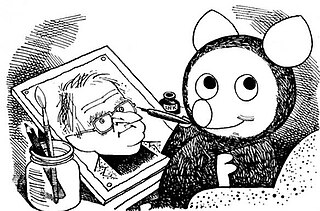Related Research Articles

A comic strip is a sequence of cartoons, arranged in interrelated panels to display brief humor or form a narrative, often serialized, with text in balloons and captions. Traditionally, throughout the 20th and into the 21st century, these have been published in newspapers and magazines, with daily horizontal strips printed in black-and-white in newspapers, while Sunday papers offered longer sequences in special color comics sections. With the advent of the internet, online comic strips began to appear as webcomics.

Dilbert is an American comic strip written and illustrated by Scott Adams, first published on April 16, 1989. It is known for its satirical office humor about a white-collar, micromanaged office with engineer Dilbert as the title character. It has led to dozens of books, an animated television series, a video game, and hundreds of themed merchandise items. Dilbert Future and The Joy of Work are among the best-selling books in the series. In 1997, Adams received the National Cartoonists Society Reuben Award and the Newspaper Comic Strip Award for his work. Dilbert appears online and as of 2013 was published daily in 2,000 newspapers in 65 countries and 25 languages.

The National Cartoonists Society (NCS) is an organization of professional cartoonists in the United States. It presents the National Cartoonists Society Awards. The Society was born in 1946 when groups of cartoonists got together to entertain the troops. They enjoyed each other's company and decided to meet on a regular basis.

Humphrey Richard Adeane Lyttelton, also known as Humph, was an English jazz musician and broadcaster from the Lyttelton family.

Murat Bernard "Chic" Young was an American cartoonist who created the comic strip Blondie. His 1919 William McKinley High School Yearbook cites his nickname as Chicken, source of his familiar pen name and signature. According to King Features Syndicate, Young had a daily readership of 52 million. Stan Drake, who drew Blondie in the 1980s and 1990s, stated that Young "has to go down in history as one of the geniuses of the industry."

Alan George Heywood Melly was an English jazz and blues singer, critic, writer, and lecturer. From 1965 to 1973, he was a film and television critic for The Observer; he also lectured on art history, with an emphasis on surrealism.

Walter Ernest Fawkes, also known as Trog when signing cartoons, was a Canadian-British jazz clarinettist and satirical cartoonist.

King Features Syndicate, Inc. is an American content distribution and animation studio, consumer product licensing and print syndication company owned by Hearst Communications that distributes about 150 comic strips, newspaper columns, editorial cartoons, puzzles, and games to nearly 5,000 newspapers worldwide. King Features Syndicate also produces intellectual properties, develops new content and franchises, and licenses its classic characters and properties.
A daily strip is a newspaper comic strip format, appearing on weekdays, Monday through Saturday, as contrasted with a Sunday strip, which typically only appears on Sundays. They typically are smaller, 3–4 grids compared to the full page Sunday strip and are black and white.
Arthur Horner was an Australian cartoonist, active for much of his working life in Britain, and best known for the comic strip Colonel Pewter.

The Newspaper Enterprise Association (NEA) is an editorial column and comic strip newspaper syndication service based in the United States and established in 1902. The oldest syndicate still in operation, the NEA was originally a secondary news service to the Scripps Howard News Service; it later evolved into a general syndicate best known for syndicating the comic strips Alley Oop, Our Boarding House, Freckles and His Friends, The Born Loser, Frank and Ernest, and Captain Easy / Wash Tubbs; in addition to an annual Christmas comic strip. Along with United Feature Syndicate, the NEA was part of United Media from 1978 to 2011, and is now a division of Andrews McMeel Syndication. The NEA once selected college All-America teams, and presented awards in professional football and professional basketball.

Jungle Jim is the fictional hero of a series of jungle adventures in various media. The series began on January 7, 1934, as an American newspaper comic strip chronicling the adventures of Asia-based hunter Jim Bradley, who was nicknamed Jungle Jim. The character also trekked through radio, film, comic book and television adaptations. Notable was a series of films and television episodes in which Johnny Weissmuller portrayed the safari-suit wearing character, after hanging up his Tarzan loincloth. The strip concluded on August 8, 1954.
Richard Arnold Moores was an American cartoonist whose best known work was the comic strip Gasoline Alley, which he worked on for nearly three decades.
Notable events of 1949 in comics.

Our Boarding House is an American single-panel cartoon and comic strip created by Gene Ahern on October 3, 1921 and syndicated by Newspaper Enterprise Association. Set in a boarding house run by the sensible Mrs. Hoople, it drew humor from the interactions of her grandiose, tall-tale-telling husband, the self-styled Major Hoople, with the rooming-house denizens and his various friends and cronies.

Andrée Melly was an English actress.

The McNaught Syndicate was an American newspaper syndicate founded in 1922. It was established by Virgil Venice McNitt and Charles V. McAdam. Its best known contents were the columns by Will Rogers and O. O. McIntyre, the Dear Abby letters section and comic strips, including Joe Palooka and Heathcliff. It folded in September 1989.

Frank E. Leonard, better known as Lank Leonard, was an American cartoonist artist who created the long-running comic strip Mickey Finn, which he drew for more than three decades.

AP Newsfeatures, also AP Features, was the cartoon and comic strip division of Associated Press, which syndicated strips from 1930 to the early 1960s.
Sandra Fawkes was a British journalist.
References
- 1 2 Hobsbawm, Eric. "Diary", London Review of Books, 27 May 2010.
- ↑ see for instance "Flook", The Philadelphia Inquirer 23 October 1951, p. 28
- ↑ Erwin Knoll, "Young Canadian Creator of the Popular 'Flook'" Ottawa Evening Citizen, 5 April 1952 p. 24
- ↑ Robert Raymond, Giving Luck a Chance, Seaview Press, Henley Beach 2000 pp. 60-62.
- 1 2 "Biography: Wally Fawkes – The British Cartoon Archive – University of Kent". Cartoons.ac.uk. Archived from the original on 2013-05-27. Retrieved 2014-01-22.
- ↑ "Newspaper Comics: Trog's Rufus and Flook « AnimationResources.org – Serving the Online Animation Community". Animationresources.org. 2013-02-13. Retrieved 2014-01-22.
- ↑ https://www.britishnewspaperarchive.co.uk/viewer/BL/0000560/19841116/082/0013?browse=true [ bare URL ]